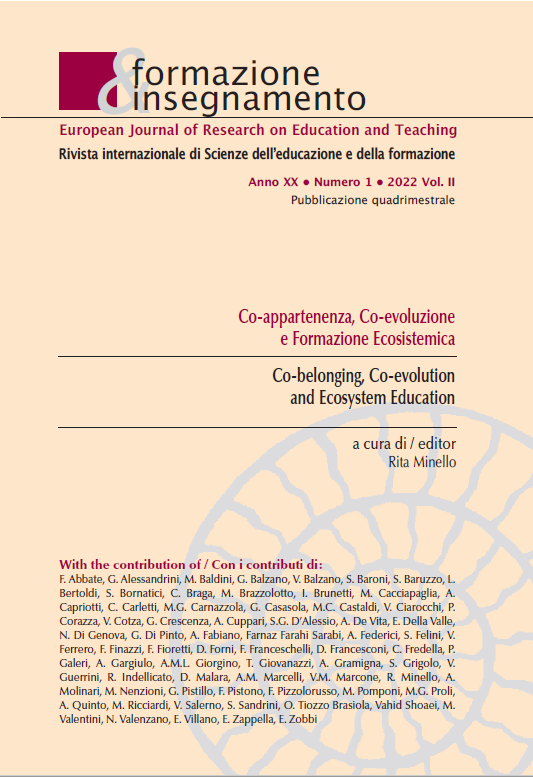Play the Tale: Educating Reading in the Digital Era through Storytelling and Play
DOI:
https://doi.org/10.7346/-fei-XX-01-22_73Keywords:
Children's literature, Storytelling, Play, Digital Era, ComplexityAbstract
The contribution aims to reflect on the importance and, above all, on the future of reading education in the digital age. The entry into the world of reading is a kind of birth because it requires an educational relationship, encouraging, facilitating, and able to promote the growth and maturation of boys and girls as autonomous readers, competent, critical, and passionate. For this reason, we will try to outline a possible path of reading education through the use of storytelling and, in particular, of reading aloud and playful activities, in the belief that the pleasure of listening to a story and the joy of playing can find meeting points that accompany children on a path of growth that does not necessarily have to pass through an exclusionary choice, but that allows us to offer children of pre-school and school-age a way that is as complete as possible and inclusive of the many playful and educational realities.
References
Bellatalla, L., Bettini, D. (2010), Leggere all’infinito. Tra pratica e teoria della lettura. Milano: Franco Angeli.
Blezza Picherle, S. (2013), Formare lettori, promuovere la lettura. Riflessioni e itinerari narrativi tra territorio e scuola. Milano: Franco Angeli.
Bologna, E., Caramis, A. (2022). Produzione e lettura di libri in Italia – Anno 2020. Roma. Statistiche Report Istat.
Bruner, J. S. (1992). La ricerca del significato. Torino: Bollati Boringhieri.
Caillois, R. (1981). I giochi e gli uomini. Milano: Bompiani.
Cambi, F. (2007). Homo ludens: gioco e realtà. In F. Cambi, G. Staccioli (Eds.) Il gioco in Occidente. Storie, teorie e pratiche, Roma: Armando.
Cambi, F. (2012). Le contraddizioni dell’infanzia nel mondo moderno. In M. Corsi, Ulivieri S. (Eds.) Progetto generazioni. Bambini e Anziani due stagioni della vita a confronto. Pisa: ETS.
Campagnaro, M., Dallari, M. (2013). Incanto e racconto nel labirinto delle figure. Albi illustrati e relazione educativa. Trento: Erickson.
Cardarello, R. (2004). Storie facili e storie difficili. Valutare i libri per bambini. Parma: Edizioni Junior.
De Mauro, T. (2010), La cultura degli italiani. Roma-Bari: Laterza.
Federighi, P. (1996), Le condizioni del leggere, Milano: Editrice Bibliografica.
Ferrieri, L. (2011). La lettura spiegata a chi non legge. Milano: Bibliografica.
Freschi, E. (2008). Le letture dei piccoli. Una proposta di “categorizzazione” dei libri per bambini da 0 a 6 anni. Tirrenia: Del Cerro.
Levorato, M.C. (2000). Le emozioni della lettura. Bologna: Il Mulino.
Nesti, R. (2012), Frontiere attuali del gioco. Per una lettura pedagogica. Milano: Unicopli.
Nobile, A. (2010) Raccontare e leggere in famiglia e a scuola. In F. Bacchetti (Ed.), Attraversare boschi narrativi. Tra didattica e formazione (pp. 89-104). Napoli: Liguori.
Pennac, D. (1993). Come un romanzo. Milano: Feltrinelli.
Rivoltella, P. C. (2012), Neurodidattica. Insegnare al cervello che apprende. Milano: Raffaello Cortina.
Roncaglia, G. (2010). La quarta rivoluzione. Sei lezioni sul futuro del libro, Roma-Bari: Laterza.
Rovatti, P.A., Zoletto, D. (2005). La scuola dei giochi. Milano: Bompiani.
Simone, R. (2012). Presi nella rete. La mente ai tempi del web. Milano: Garzanti.
Solimine, G. (2010). L’Italia che legge. Roma-Bari: Laterza.
Staccioli, G. (2008). Il gioco e il giocare. Elementi di didattica ludica. Roma: Carocci.
Valentino Merletti, R. (2000). Leggere ad alta voce, Milano: Mondadori.
Valentino Merletti, R. (2010). Il ruolo della lettura ad alta voce nell’infanzia e nell’adolescenza. In F. Bacchetti (Ed.), Attraversare boschi narrativi. Tra didattica e formazione (pp. 105-114). Napoli: Liguori.
Wolf, M. (2007). Proust e il calamaro. Storia di scienza e del cervello che legge. Milano: Vita e Pensiero.
Downloads
Published
How to Cite
Issue
Section
License
Copyright (c) 2022 Michela Baldini

This work is licensed under a Creative Commons Attribution 4.0 International License.
Formazione & insegnamento is distributed under Attribution 4.0 International (CC BY 4.0).
For further details, please refer to our Repository & Archiving Policy, as well as our Copyright & Licensing Terms.





